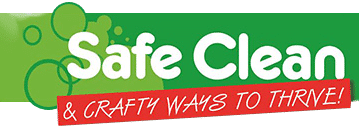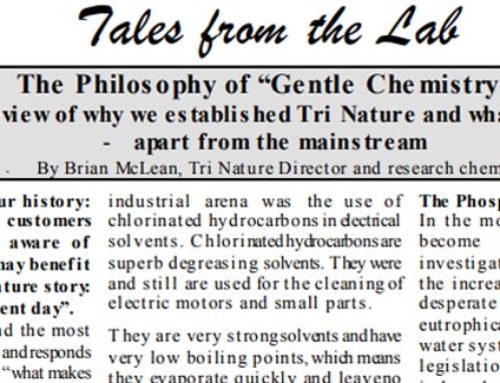
A case study of corporate ethics in a murky marketplace
BY TRACEY FREINBERGER
Tracey, General Manager of Tri Nature Pty Ltd, was a guest speaker at the Natural Health Society’s June 2008 Seminar and this article is based on her talk at that event.
A key marketing challenge in the ever-growing ‘green industry’ is the drive to provide ‘all natural’ products while delivering the performance level of their synthetic or petroleum based equivalents. It can also prove difficult to maintain a commitment to a green philosophy, rather than profit for shareholders or overseas investors.
Going beyond the label claim of ‘all natural’ is what enables some companies to stand out as benchmarks for corporate and environmental integrity. So, if the marketplace demands natural products but also wants products that really work, Tri Nature’s response has always been, “Why compromise when you can have both?”
This requires more than just paying lip service to biodegradability, or conjuring up a list of ingredients sourced from nature. It requires great technical expertise to extract, blend and activate those ingredients in the gentlest possible manner to create the safest possible product.
Code of practice
Applying the principle and practice of ‘Gentle Chemistry’, the objective is to harness the harmonies between science and nature to deliver biodegradable products that:
These are the criteria that drive Tri Nature’s product development, rather than simply being able to claim ‘all natural’. This is not the ‘normal’ practice of the industry as a whole, as a brief case study in marketing ethics will show.
SLS and the rest
Many readers would remember the heated debate back in the late 1990s regarding the detergent agent ‘SLS’. This ingredient became a terrific marketing tool for scaremongers, who interpreted technical information about its properties (some of it completely erroneous) to make their product look like the only safe alternative.
The use of slogans like ‘chemical’ vs ‘natural’ became commonplace at this time, and the practice of listing only the source ingredients on labels (and not their scientific, processed names) abounded. Ironically, SLS can be derived from coconut oil! SLS is simply the name of the compound resulting from processing the base fatty alcohol to create the desired surfactant properties.
It became the ‘in’ thing to offer SLSfree shampoos, body washes and laundry products. Further down the track, when this was no longer a unique selling point, the entrepreneurial ‘green’ marketing teams found new targets (SLES, then ALS and MgLS), finally causing the market to believe that any type of ‘sulphated’ ingredient was ‘bad’ for your health – and by proxy, the environment – not to mention all the other ‘really dangerous’ ingredients that have come under fire over the years!
While the ideology was nice, most of the products produced to fit the ‘new ideal’ simply didn’t work well – and set back the green industry many years as products appeared and disappeared while companies tried to compete solely on the basis of offering a ‘natural’ or ‘sulphate-free’ alternative. The fact is that scientific expertise can make a dangerous chemical harmless – and the lack of it can cause a harmless, natural ingredient to become dangerous. Techniques such as ‘amelioration’, or even creating a product with larger molecular structure, can reduce the likelihood of skin irritation and/or absorption.
People who use Tri Nature products attest not only to their gentleness but also to their efficacy. However, if you don’t have a relationship with a company or its products, how do you decipher the facts and distinguish the fiction? It is hard to feel peace of mind about product claims in the face of what appears to be scientific evidence that ‘chemicals are bad for you’.
Would you, for example, buy a product from me if I told you the ingredient list included ethyl acetate, ISO butyraldehyde, methyl hexanoate, 2-butanol, ethyl butyrate, acetaldehyde, ethyl 2-methylbutyrate, benzaldehyde, propyl butyrate, butyl butyrate, propyl propionate, butyl aldehyde, diethyl succinate, methyl butyrate …?
Let’s say you were prepared to believe that I wouldn’t sell you anything bad – but you chose to investigate the first two ingredients on the list by Googling online just in case. You would probably come across what’s known as a Material Safety Data Sheet (MSDS). This is a technical sheet covering the various categories of safety for a specific material.
Very scary stuff!
Here are some excerpts from the MSDS for ethyl acetate. “May affect genetic material (mutagenic). May cause adverse reproductive effects based on animal test data. No human data found at this time. May cause respiratory tract and mucous membrane irritation. May affect respiration and may cause acute pulmonary oedema. May affect gastrointestinal tract (nausea, vomiting). May affect behaviour/central nervous system (mild central nervous system depression – exhilaration, talkativeness, boastfulness, belligerence, vertigo, diplopia [double vision], drowsiness, slurred speech, slowed reaction time, dizziness, lightheadedness, somnolence).”
If you haven’t shut down the computer and run screaming from the room yet, you keep going to the second ingredient. The MSDS for butyraldehyde tells you the following. “Carcinogenic Effects: Classified 2B (possible for human) by IARC.
Repeated or prolonged exposure to the substance can produce target organs damage (blood, liver, mucous membranes, upper respiratory tract, skin, central nervous system), eye, lens or cornea…”
At this point, you would surely have decided you’re not going to buy that product.
Surprise, surprise!
The trouble is that these and the other ingredients mentioned above are just 14 from a list of 80 chemical compounds isolated from … a GRANNY SMITH APPLE! And doctors say they’re great for our health!
Mother Nature knows how to balance the chemical compounds of which all living things are made. Emulating those harmonies is the art of ‘Gentle Chemistry’
You can see, however, that a less ethical marketing approach need only include those awful effects in their marketing material to scare people into (a) using only products with natural sounding ingredient lists, or (b) using only products without those ingredients in them.
Once this becomes the norm, the pressure is on to find new ‘natural’ claims. Look at how the attention turned to ‘organic’, then to ‘certified organic’ and now ‘biodynamic’. Maybe next week it will be ‘cosmic’!
Please don’t misunderstand. Growing ingredients sustainably, without harmful chemical sprays, is the best practice and essential for our survival on this planet. We know that eating organically-grown foods is healthier, but the focus for Tri Nature in our field of personal care and cleaning products is on pesticide-free ingredients for the sake of the soil and air. Equally importantly, there will be no pesticides entering our bodies through the skin.
We take these plant-based (and some mineral) ingredients and combine them (for example, by emulsifying, mixing, blending) into something new, as does every other ‘natural’ product manufacturer. Coconut oil is no longer coconut oil – it has become one of many detergent agents whose scientific names include decyl glucoside, coco-betaine, cocoamphodiacetate or SLES.
Tri Nature always lists the ingredient by its processed name, not the natural form (unless the ingredient remains 100% in its natural form in a product, for example, essential oil of rosemary), as part of our commitment to total transparency. This has disadvantaged us in the past, as the emphasis through media and marketing has been so focused on looking for ingredient lists that are full of ‘natural’ and not ‘chemical’ ingredients.
Recently, we started to develop a new skin and body care range. Our objective was once again to provide a line that was natural but still worked, so we began looking at brands that were making the loudest claims regarding the ‘purity’ of their ingredients and investigated what we’d have to do in order to compete with such a line.
On one website, the lovely-looking lists claimed that all ingredients were oils or juices of plants or herbs from organic sources. Organic aloe vera leaf juice, rosehip seed oil, jojoba seed oil, safflower seed oil, shea fruit butter, sugar-cane ethanol, non-GMO lecithin, organic bitter orange extract, natural gum, olive leaf extract, calendula extract, chamomile extract, marshmallow extract, St John’s Wort extract – to name a few!
Who would know?
Nice – but to be accurate, the extracts in the above list are not oils or juices, but normally contain the water soluble principles of herbs which are extracted using different vehicles, for example, glycols, glycerine or alcohol. Sugarcane ethanol is neither an extract nor a juice – it’s a product of the fermentation and distillation of a sugar solution and is a completely different molecule to any contained in the original sugar cane.
There’s also not sufficient emulsifying or preservative power evidenced in the list to create a cream with any marketable shelf life. So what else aren’t they saying?
Now, we don’t have a problem with them doing what they want and how they want it, and I am sure their products are quite lovely – but on the same company’s website, a ‘typical’ moisturiser ingredient label is depicted, showing that the product contains water, dimethicone (silica), carbomer 941, PEG-50 almond glycerides (almond) sodium laureth sulphate (coconut), cocoamidopropyl hydroxysultanet (sic), triethanolamine (TEA), methylchloroisothiazolinone, phenoxyethanol, methyl paraben (organic preservative), FD&C yellow No.6, fragrance.
This list links to an MSDS sheet for each of the ingredients they knew to have ‘shocking looking’ credentials regarding harmful properties, as per the previous exercise.
However, most of the ingredients listed in the ‘typical’ product wouldn’t be used in any kind of skin care creams today – certainly not all in a single product, let alone a typical one!
Would many people know this and hence give further consideration to a product containing any of these ingredients?
Standing firm
Brian McLean, Tri Nature’s Technical Director, was about to deliver a spectacular range of natural skin care that really works and we didn’t want to suffer again in the marketplace from our own strict policies, nor did we want to compromise our principles.
This led us to the decision to list both the natural and the scientific names of the ingredients in our new KYPHI Skin and Body range. Further, ingredients are shown as certified organic where indeed they have been certified, rather than just listed as organic for the perceived marketing benefit (you don’t normally use pesticides to grow coconut palms!).
Tracey Freinberger’s lengthy and diverse marketing and business management background in media, hospitality and training led to her being offered the position of General Manager of Tri Nature Pty Ltd in 2001.
Tri Nature, founded in 1989, is a multi-award winning, specialist, eco-focused subsidiary of Hammersley Industries, a highly respected Australian chemical company based in Newcastle, which has been developing and manufacturing innovative and responsible chemical products since July 1972.
For more information about the new KYPHI Skin and Body range, please see page 74 of this issue. Earlier articles on negative product propaganda, as well as Tri Nature’s history and development, can be found in the following issues: Spring 2002, Winter 2003, Spring 2003, Summer 03/04 and Autumn 2005.






Leave A Comment